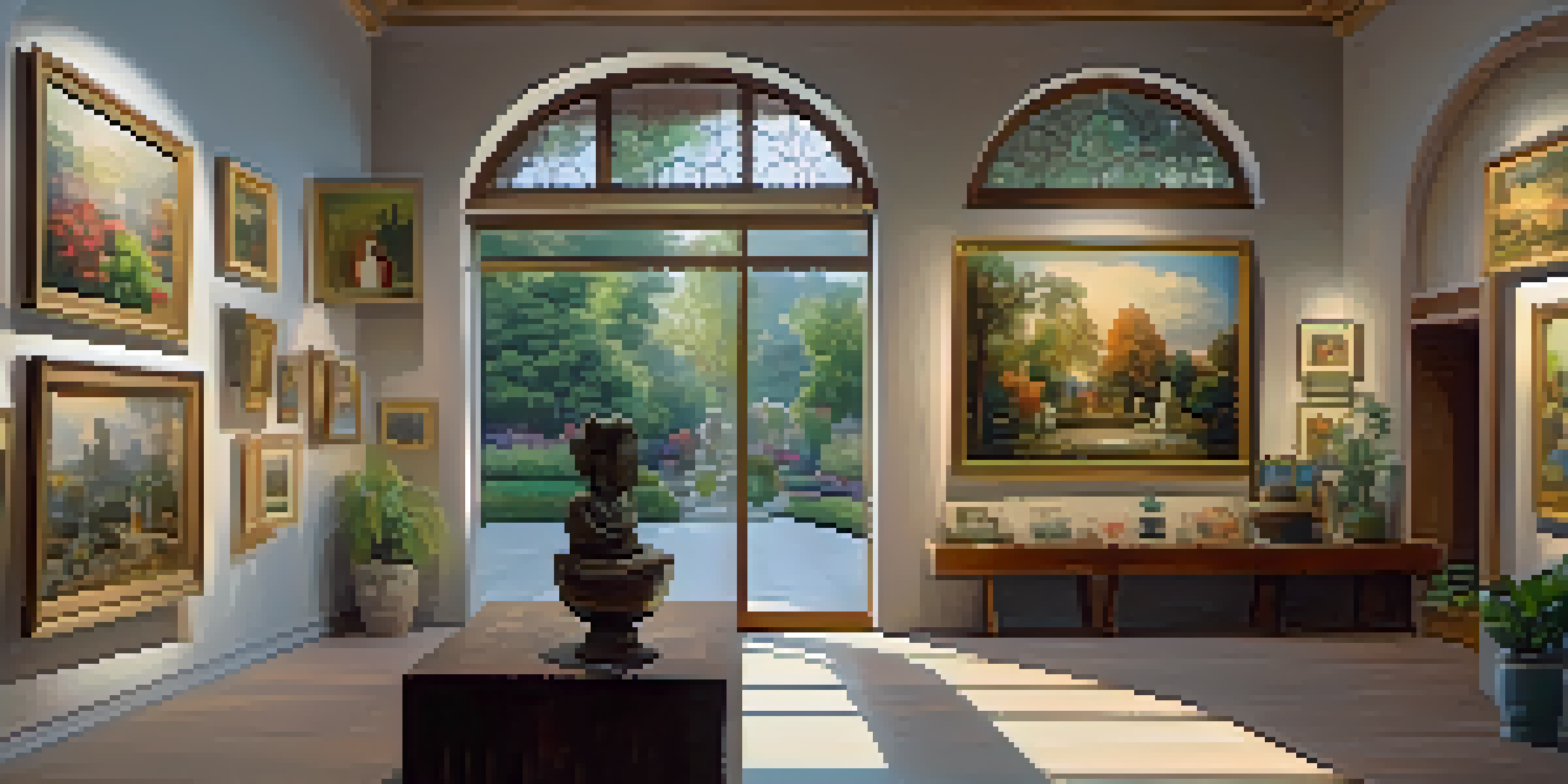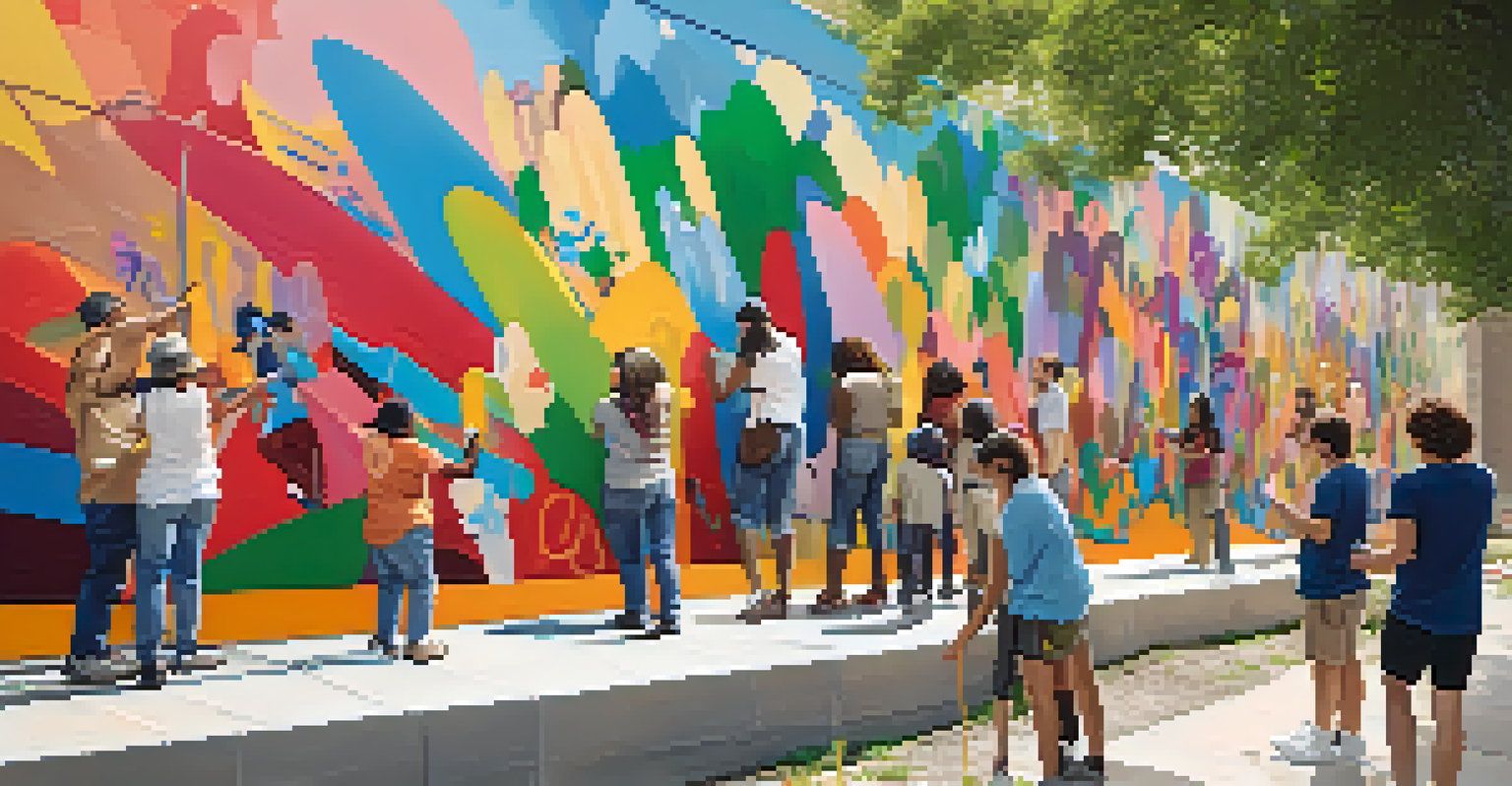Engaging with Art: A Strategy for Empathy Building

Understanding Art as a Reflection of Humanity
Art has always served as a mirror to society, reflecting the joys, sorrows, and complexities of human experience. By engaging with various forms of art, we gain insight into different perspectives and emotions. For instance, a powerful painting depicting despair can evoke a strong emotional response, allowing us to connect with the artist's feelings. This connection is the first step in building empathy, as we begin to understand the experiences of others.
Art enables us to find ourselves and lose ourselves at the same time.
Moreover, art often encapsulates cultural narratives and histories that might be different from our own. When we take the time to explore these stories through art, we broaden our understanding of the world. Imagine walking through an art gallery filled with pieces from various cultures; each piece tells a story that invites us to step into someone else's shoes. This exploration not only enriches our knowledge but also nurtures our capacity for empathy.
In essence, engaging with art allows us to transcend our personal experiences, fostering a sense of shared humanity. As we resonate with the emotions and stories portrayed in art, we cultivate an understanding that goes beyond surface-level interactions. This deeper connection is crucial in today’s diverse society, where empathy can bridge gaps and foster relationships.
Experiencing Art: The Role of Emotions
When we engage with art, our emotions play a pivotal role in how we interpret and connect with it. Art has the power to evoke feelings that can be both profound and personal. For example, a haunting melody in a song can stir memories and feelings that resonate deeply within us, creating an emotional bond. This emotional engagement is essential in developing empathy, as it encourages us to feel alongside others rather than just observing their experiences.

Additionally, experiencing art often prompts us to confront our own emotions and biases. A thought-provoking film or a challenging piece of literature can push us to reflect on our beliefs and assumptions. This introspection can be uncomfortable, but it is a necessary step toward understanding others. By recognizing our feelings, we become more equipped to empathize with the emotions of those depicted in art.
Art Fosters Empathy and Connection
Engaging with art allows us to connect emotionally with others, enhancing our understanding and empathy for diverse experiences.
Ultimately, the emotional experience of engaging with art can lead to transformative moments. When we allow ourselves to truly feel, we open the door to understanding the complexities of human emotions. This journey into our own hearts can make us more compassionate individuals, ready to embrace the feelings of others.
Art as a Bridge for Cultural Understanding
Art serves as a powerful bridge between cultures, allowing us to appreciate and understand different backgrounds. Through various forms of artistic expression, from traditional dances to modern installations, we can explore the values and beliefs that shape different communities. For instance, attending a cultural festival can expose us to various art forms and narratives, enriching our understanding of the world around us.
Every artist was first an amateur.
By engaging with art from diverse cultures, we begin to dismantle stereotypes and misconceptions. When we see the beauty in a story told through a different lens, we become more open-minded and accepting. Each piece of art is a conversation starter, inviting us to ask questions and seek to understand rather than judge. This dialogue is crucial in building empathy across cultural divides.
Furthermore, experiencing art from other cultures can inspire us to reflect on our own identity and values. It encourages a sense of curiosity and respect for diversity, fostering a connection that transcends geographical boundaries. In a world that can often feel divided, art reminds us of our shared humanity, paving the way for deeper connections and understanding.
The Therapeutic Benefits of Creating Art
Creating art is not just an expression but also a therapeutic process that can enhance empathy. Engaging in artistic activities allows individuals to process their feelings and experiences in a safe space. For example, someone who paints about their struggles can not only release emotions but also invite others to relate to their journey. This shared experience can foster deeper understanding and empathy among individuals.
Moreover, creating art often involves collaboration, which is another powerful empathy-building exercise. When artists come together to create, they must communicate and understand each other's perspectives. This exchange of ideas cultivates a sense of community and interconnectedness, reminding us that we are not alone in our experiences. Collaborative art projects can be transformative, as they weave together diverse stories and emotions.
Cultural Understanding Through Art
Art serves as a bridge between cultures, helping to dismantle stereotypes and promote open dialogue about different backgrounds.
In essence, the act of creating art can be a profound way to cultivate empathy. It encourages us to explore our emotions and connect with others in meaningful ways. Whether through painting, writing, or performing, the creative process serves as a reminder of our shared humanity, making empathy a tangible experience.
Art Education: Nurturing Empathy in Future Generations
Integrating art education into school curriculums can play a significant role in nurturing empathy among students. By exposing children to various art forms, they learn to appreciate diverse perspectives and cultural narratives. For instance, discussing a story told through a painting can encourage students to express their feelings and relate to the artist's message. This foundational understanding prepares them for a compassionate future.
Moreover, art education fosters critical thinking and emotional intelligence, essential skills for building empathy. As students analyze and interpret artworks, they develop the ability to see beyond their own experiences. This skill is crucial in today's interconnected world, where understanding different viewpoints is more important than ever. Engaging with art helps students cultivate a mindset of curiosity rather than judgment.
Ultimately, promoting art education is an investment in a more empathetic society. When children learn to appreciate and create art, they develop a deeper connection to the world around them. This connection can lead to more compassionate individuals, ready to engage with the complexities of human emotions and experiences.
Community Art Projects: A Collective Empathy Experience
Community art projects are a fantastic way to foster empathy on a larger scale. These initiatives often bring together individuals from various backgrounds to collaborate on creative endeavors. For example, a mural project that involves community members can tell a shared story, reflecting the hopes and challenges faced by residents. This collective experience not only beautifies the community but also strengthens bonds among participants.
Moreover, community art projects encourage dialogue and understanding among diverse groups. As participants share their stories and experiences through art, they create a space for empathy to flourish. This collaboration can break down barriers and promote a sense of belonging, reminding us that we are all part of a larger tapestry. The act of creating together can lead to lasting friendships and mutual respect.
Creating Art as a Healing Process
The act of creating art not only facilitates personal expression but also fosters community collaboration and shared understanding.
In essence, community art projects are powerful tools for nurturing empathy. They create opportunities for individuals to connect, share experiences, and learn from one another. Ultimately, these projects can transform communities, fostering a culture of understanding and compassion.
The Future of Empathy Through Art Engagement
As we look to the future, the role of art in fostering empathy remains more crucial than ever. In a world increasingly divided by differences, engaging with art can bridge gaps and promote understanding. Through innovative platforms and digital mediums, art continues to evolve, providing new ways for individuals to connect with one another. This evolution opens up exciting possibilities for empathy-building initiatives.
Furthermore, the rise of virtual reality and interactive art experiences presents unique opportunities for deeper engagement. Imagine stepping into a virtual artwork that allows you to experience the emotions of others firsthand. These immersive experiences can create powerful connections, enabling us to walk in someone else’s shoes like never before. Such advancements can revolutionize how we experience and understand empathy.

Ultimately, the future of empathy through art engagement is bright. As we embrace new technologies and creative expressions, we can continue to foster a culture of understanding and compassion. By prioritizing art as a means of connection, we pave the way for a more empathetic society, one that values diversity and shared human experiences.